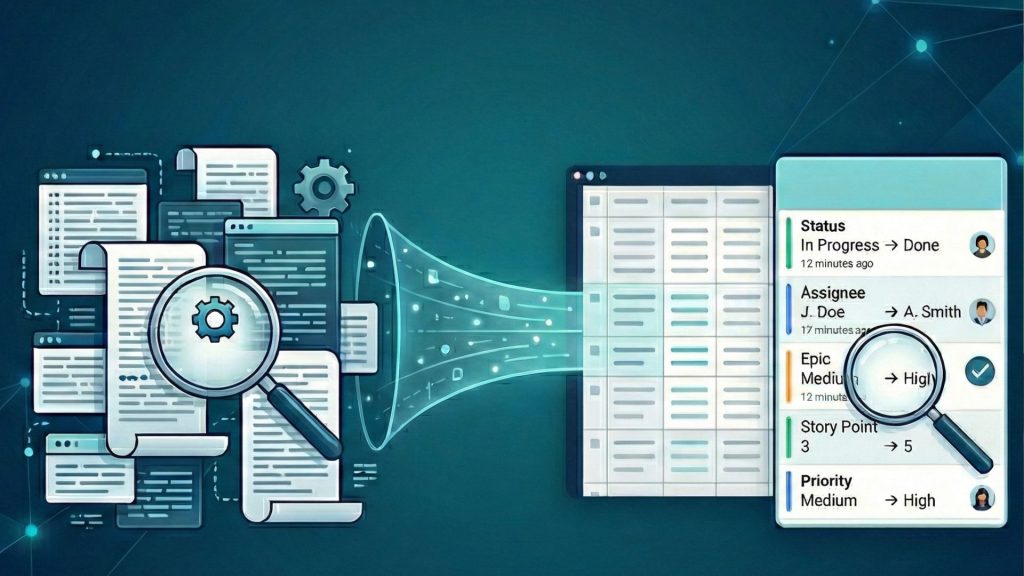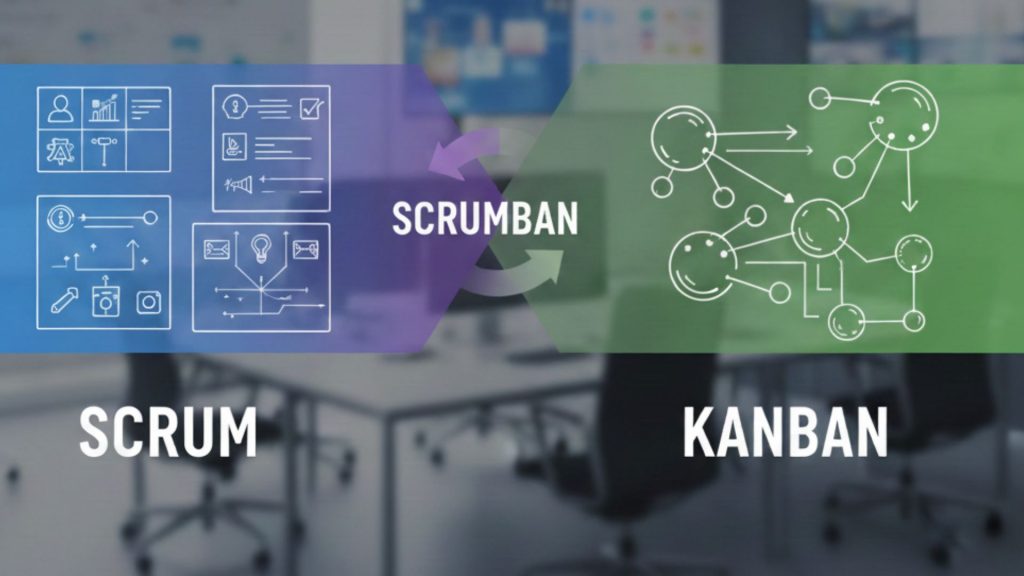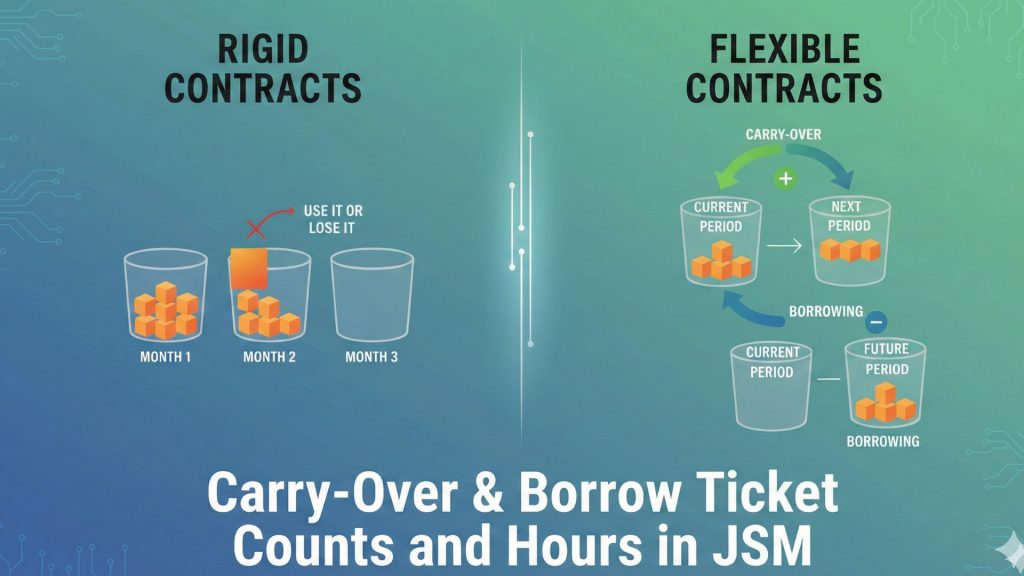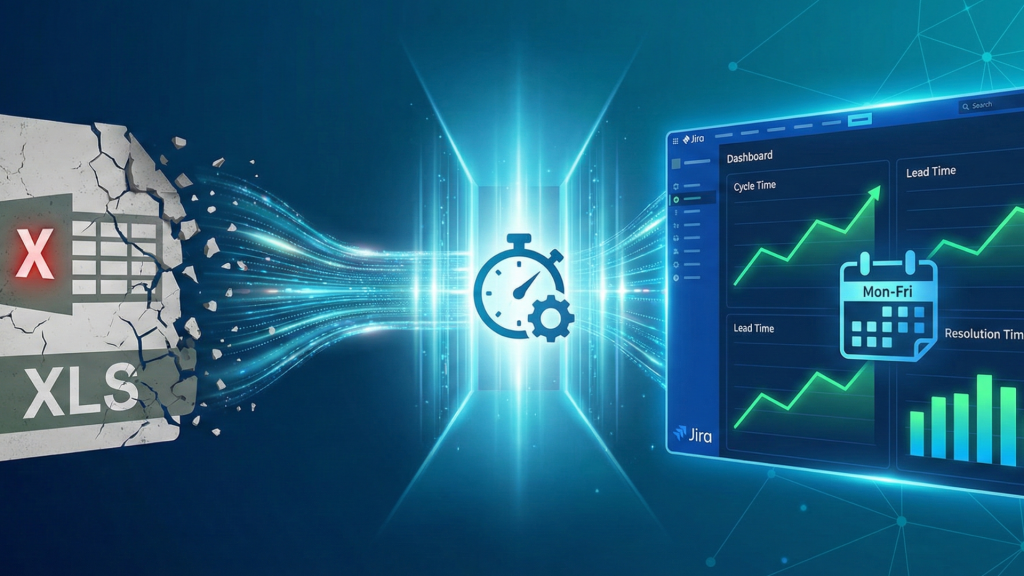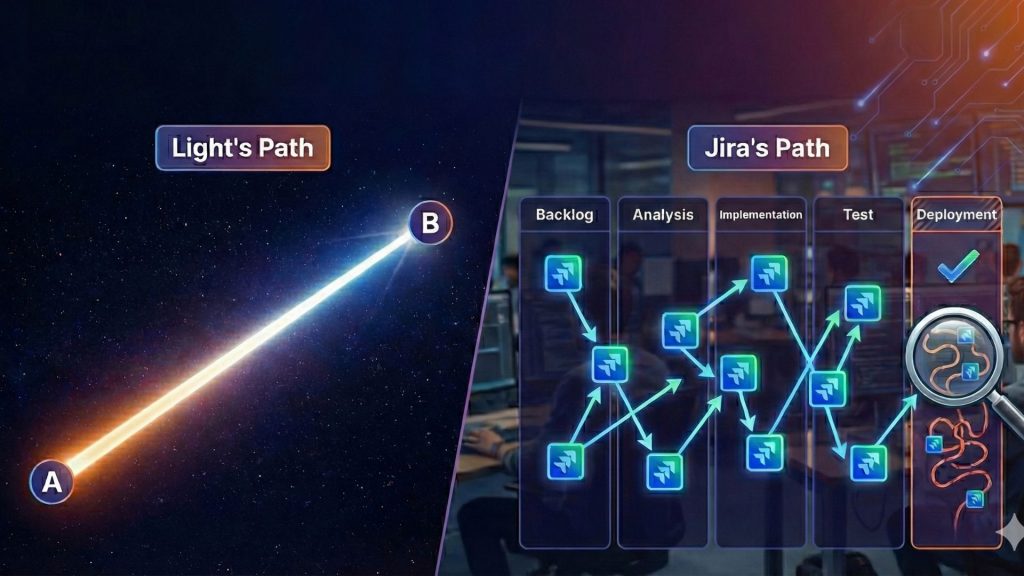Jira has become an indispensable part of our work for many of us. From project management and workflow development to KPI tracking, from reporting to team communication, Jira stands at the undisputed peak for every stage of project management, even if it’s not without rivals.
And tracking time in Jira is one of the most crucial pillars of this development cycle. Ultimately, measuring the time we spend on a task is one of the most essential data points we need when evaluating output and planning future work. But it’s more than that. We must track time effectively to improve our current workflows, identify bottlenecks, optimize the team’s workload distribution, and prepare better reports.
In this article, we’ve brought together just about everything you need to know about time tracking in general, and Jira time tracking in particular. Why is time tracking in Jira so important? What can you do, and what can’t you do, with Jira’s native features? What are the best methods for you, and how can you develop a more efficient work process without micromanagement? Let’s dive in.
What is Time Tracking in Jira? And Why Do We Need to Track Time?
As much as I’d love to start with the question ‘What is time?’, I’ll save that wonderful philosophical discussion for another blog post to respect everyone’s valuable time. So, let’s get straight to the point. In its broadest sense, time tracking in Jira is the process of recording, analyzing, and monitoring any activity related to a task from a time-related perspective. You can log, estimate, and report on time spent on work items (issues) or projects.
It’s no coincidence that the modern era is also called the ‘information age.’ Today, companies that possess the best data and know how to use it gain a significant competitive advantage. This is precisely where time tracking becomes so important. In project management, time tracking allows you to plan workflows better, optimize teams’ workloads, and make more accurate future forecasts. To gain an edge over competitors and use your company’s resources (time, money, labor) with a higher ROI, knowing ‘what time was spent on what, and by whom’ is crucial. As the saying goes: You can’t manage what you don’t measure.
Why Time Tracking is Your Most Undervalued Business Intelligence Tool?
Time tracking often gets a bad reputation for numerous reasons. It brings to mind tedious timesheets, micromanagement, and a general sense of being watched over. But what if we reframed that thinking? What if we don’t see it as a tool in the hands of ‘Big Brother?’ What if, instead of a chore, time tracking was your organization’s most valued source of business intelligence?

Data is the new gold, as I said and will say many times. And accurate, automated time tracking is the main source of strategic decision-making. It transforms ambiguity into clarity, allowing you to move beyond guesswork and manage your projects, resources, and budgets with data, means with confidence.
How Time Data Drives Profitability, Predictability, and Performance
Let’s make something very clear: We are not talking about just ‘logging hours’ when we say ‘time tracking.’ The reason we think time tracking in Jira is crucial is that it’s all about understanding where that time goes. When you have a clear picture of your team’s effort, you unlock three critical business advantages:
Profitability
By understanding the true time cost of projects, features, and even bug fixes, you can accurately price your services, manage budgets effectively, and ensure every initiative contributes to the bottom line.
Predictability
How can you promise a delivery date if you don’t know how long similar work has taken in the past? Historical time data is the foundation of accurate forecasting, allowing you to set realistic deadlines, manage stakeholder expectations, and deliver on your commitments consistently.
Performance
Time data exposes the hidden friction in your workflows. It reveals the bottlenecks, the wait times, and the process gaps that slow your team down. By identifying these areas, you can make targeted improvements that boost efficiency and overall team performance.
Who is This Guide For? A Look at What Time Tracking Solves for Your Role
The value of time tracking isn’t one-size-fits-all. Different roles have different problems to solve, and time data provides unique solutions for each.
For Project Managers
As a Project Manager, you live in a world of deadlines, budgets, and stakeholder expectations. Your primary challenge is navigating the constant ‘what’s the status?’ while juggling resources. Time tracking is your command center. It provides the clarity needed to:
- Deliver on time and on budget by comparing planned effort against actual time spent.
- Allocate resources effectively, ensuring no team member is overburdened while others are underutilized.
- Identify scope creep early when tasks consistently run over their estimates.
- Communicate with stakeholders confidently, providing clear, data-backed status reports instead of vague updates.
For Scrum Masters & Agile Coaches
Your role is to be the guardian of the agile process, helping the team become more efficient and effective. But without objective data, retrospectives can devolve into opinion-based discussions that lead nowhere. Time tracking gives you the concrete evidence needed to:
- Facilitate powerful, data-driven retrospectives by pinpointing the exact stages in the workflow where work items (formerly known as issues) linger.
- Protect the team from over-commitment by using historical data to make sprint planning more realistic.
- Improve team velocity and predictability by understanding the true effort required for different types of work.
- Coach the team effectively, using metrics to highlight opportunities for improvement in a neutral, objective way.
For Engineering Leads
You’re tasked with maximizing your team’s output while ensuring they remain engaged, motivated, and free from burnout. The fear of being seen as a micromanager can make tracking performance a challenge. But, as we talked before, time tracking is about optimizing the system they work within. You can:
- Identify systemic bottlenecks that frustrate your developers.
- Ensure fair workload distribution, preventing a few team members from becoming overloaded while others have capacity.
- Protect your team from unrealistic deadlines by using historical data.
- Justify the need for more resources by demonstrating where the current team’s capacity is being stretched thin.
For Finance & Operations
For business leaders, time is quite literally money. Every hour spent on a project is a direct cost. Accurate time tracking is essential for financial health and operational efficiency. It enables you to:
- Ensure accurate client billing and invoicing, reducing disputes and improving cash flow for service-based businesses.
- Calculate true project profitability by comparing the total time cost against the project’s revenue.
- Provide auditable worklogs for R&D tax credits, a high-value activity that can result in significant savings.
- Make informed decisions about resource allocation across different departments and strategic initiatives.
For Service & Support Managers
Your world revolves around ticket queues, customer satisfaction, and the relentless ticking clock of Service Level Agreements (SLAs). Your primary goal is to ensure issues are resolved efficiently and effectively, but you often lack the data to see where your process is truly succeeding or failing. Time tracking provides the critical insights you need to:
- Optimize agent workload and performance by seeing how time is distributed across different ticket types, agents, and support teams, allowing you to balance workloads, identify coaching opportunities, and recognize top performers.
- Identify process bottlenecks that impact resolution times, such as tickets waiting on information from other departments or getting stuck in a specific support tier.
- Recognize trends to take proactive actions before things start to break.
- Justify headcount and resource needs with concrete data that shows the total time required to handle your current ticket volume.
For a Complete View: Worklogs & Workflow Intelligence
Before we go any further, it’s critical to understand that time tracking in Jira represents two fundamentally different perspectives.

The first is worklog-based tracking. This involves users logging the hours they spend on a task. It’s designed to answer the question, “How much time did an employee work on this issue?”. This approach is essential for generating timesheets, cost calculation, managing client billing, or tracking effort for capitalization. While incredibly important, this method of active time logging is a separate discipline focused on individual accountability. Jira’s native time tracking feature relies on this perspective.
The second perspective is ‘history-based’ analysis. This approach doesn’t rely on manual entries. Instead, it analyzes the data Jira is already creating every second: the timestamps of every status change, every assignment, every update. This method targets questions like: “How long does our process take? Where are the bottlenecks? Where is the process breaking down?”
How Does Jira’s Native Time Tracking Feature Work?
At its core, Jira’s worklog-based time tracking allows users to log work against individual issues, creating a simple record of time spent. Three key fields work together:
Original Estimate: The initial prediction of how long a task will take.
Time Spent: The cumulative amount of time team members have logged working on the task.
Remaining Estimate: The time left to complete the work. Intended to be manually updated at regular intervals throughout the work. Jira can also automatically adjust as time is logged onto the work item.
This process is manual. To use it, a user opens an issue, selects “Log Work,” and enters the time they’ve spent. This creates a worklog, which is a simple entry that captures who did the work and for how long.
Jira’s native time tracking helps teams answer basic questions about task completion and sprint progress. The data gathered feeds directly into some of Jira’s standard agile reports, like Burndown and Velocity charts, helping teams see if they are on track within a sprint. It provides a fundamental level of accountability and is a useful starting point for teams new to tracking their time.
For teams that need to manage budgets, report to stakeholders, or optimize complex workflows, its simplicity quickly becomes a significant restraint. Let’s discuss these limitations.
Limitations of Native Jira Time Tracking
Jira’s native time tracking provides a strong and essential foundation for the worklog-based approach. However, as your team’s needs for deeper workflow analysis grow, you may find that you require more capabilities than what is available out of the box. The following section details some of the limitations you might encounter.
The Challenge of Manual Time Entry
Jira’s native system relies entirely on team members manually entering their time, a process that may create challenges for growing teams. For example, users quite often see “logging time” as chore work. The need for complete data often forces managers into a cycle of reminding their teams to log their hours. This can feel like micromanagement to employees and turns a process that should be helpful into a source of frustration for everyone involved.
Why Can’t You Get a Simple Timesheet?
Ask any project manager for their most basic reporting need, and the answer is almost always a simple timesheet: “Show me all the time logged by my team this week, grouped by project.”
In native Jira, this is difficult to produce. There is no built-in, out-of-the-box timesheet report. While you can view individual worklogs on an issue, getting a consolidated view requires exporting data and manually wrestling with it in a spreadsheet.
The Challenge of Cross-Project and Portfolio Reporting
A single project team might be able to survive with basic reports. But what happens when a manager needs to see the total time spent by their entire department across 3 different projects?
This is exactly where native Jira time tracking feature fails. It was not designed for high-level, cross-project portfolio management. There are no built-in reports that can easily aggregate time tracking data across multiple projects. To get this crucial overview, managers are forced to export data from each project individually and then manually combine and analyze it in an external tool. This process simply does not scale.
The Difficulty of Exporting Clean Data to Excel or BI Tools
“I’ll just export it” is a common saying, but this is another trap. Jira’s native CSV export is limited.
First, it’s capped at 1,000 issues, making a complete data for any reasonably sized project a frustrating, multi-step ordeal. Second, the export often strips away crucial context. Key data like issue history, comments, and attachments are left behind, forcing you to constantly cross-reference between your spreadsheet and Jira to understand the full story. This makes it nearly impossible to use the data for serious financial analysis or to feed it into powerful Business Intelligence (BI) tools like Power BI or eazyBI. To overcome this limitation, Jira’s REST API can help for generating fully customized, advanced reports.
A Two-Fold Path to Time Mastery
Once you acknowledge the limitations of native Jira, the solution seems clear: find an app in the Atlassian Marketplace to fix the problem. This is the correct first step, but only addresses half of the equation. To truly master time in Jira, you need a two-fold approach.
Part 1: Perfecting the Timesheet
The most immediate pain points, like the chore of manual time entry, the lack of consolidated timesheets, and the difficulty of cross-project reporting, are all problems related to the worklog. The solution is a dedicated timesheet application. These apps streamline the process of logging hours, provide the clean, manager-friendly reports that native Jira lacks, and make exporting data for billing or financial analysis straightforward. By implementing a timesheet app, you solve the problem of accurately tracking effort.
Part 2: Unlocking Workflow Intelligence
However, perfecting the timesheet is only half the story. While it tells you how much time was spent, it fails to answer a more critical question: Why did it take so long? The most significant delays and inefficiencies in a project are often hidden not in the time people actively work, but in the time work sits idle, waiting in queues, blocked by dependencies, or stuck in review cycles.

Answering this question requires a shift from tracking logged time to analyzing the entire process flow. This is the realm of workflow intelligence. The source of truth for this analysis is not the manually entered worklog, but Jira’s own automated issue history. By analyzing this rich, objective data, you can uncover bottlenecks, measure cycle times & lead times, and gain true business intelligence about your team’s efficiency. This requires a different kind of app, one designed not to log time, but to interpret it. This is where we shift Jira time tracking to the next level and introduce tools like Timepiece – Time in Status for Jira.
Read our latest article to learn more about combining history-based time tracking with Worklog-based time tracking to get a 360-degree view of your business.
‘Must-Have’ Features for A Good Jira Time Tracking App
Use this buyer’s checklist before starting any free trial to ensure you choose a complete solution. These are the core features that separate basic apps from true enterprise-grade tools. While these capabilities are crucial for any serious time tracking app, they are the absolute foundation for mastering the history-based approach to unlock true process insights.
Automated & Flexible Time Capture
The most significant barrier to accurate time data is its reliance on human memory. A professional solution must address this problem head-on by making time capture as effortless and accurate as possible.
In the Atlassian Marketplace, you’ll find apps that solve this through two distinct philosophies: worklog-based automation and history-based analysis.
Worklog-based tools focus on making the manual logging process easier. They often include features like one-click timers or calendar integrations that help employees capture the hours they actively work on a task. This approach is excellent for generating employee timesheets or for client billing.
History-based tools take a different approach. Instead of focusing on manual entries, they analyze the automatic timestamps that Jira already creates every time an issue changes status. This method is designed to measure the duration of a process like how long an issue was “In Review” or “Waiting for QA.”
Both methods provide a form of automation and have their advantages. The crucial first step in choosing an app is to ask: “What question am I trying to answer?” Is your primary goal to track an employee’s logged hours, or is it to analyze and optimize the flow of work through your system? Understanding which of these two approaches best fits your needs is the key to finding the right solution.
Enterprise-Grade Custom Calendars (Work Hours, Holidays, Time Zones)
This is non-negotiable and the only way to solve the ‘24/7 Accuracy Catastrophe.’ An enterprise-grade solution must allow you to define your own reality. This means creating unlimited custom calendars that reflect how your teams work, including the following:
Specific Working Hours: (e.g., 9:00 AM – 5:00 PM, not 24 hours a day).
Public Holidays: Unique holiday schedules for teams in different countries.
Multiple Time Zones: Ensuring that your distributed team’s data is normalized and accurate.
Without this, your cycle time, lead time, and SLA calculations will always be fundamentally flawed.
Granular, Customizable Reporting App for Strategic Insight
A professional time tracking app moves beyond simple data exports to provide a dynamic analytics workbench. It must be powerful enough to deliver actionable intelligence to all stakeholders, from project managers to the C-suite, within Jira.
An effective solution offers a multi-layered reporting capability:
Operational Reporting: It must effortlessly handle foundational business needs. This includes the instant generation of accurate, user-centric timesheets for any period and consolidated Cross-Project Reports that provide leadership with a high-level portfolio view of resource allocation.
Diagnostic Intelligence: The engine must empower managers to diagnose workflow health and answer critical process questions. It should provide clear metrics on Time in Status to identify bottlenecks, calculate true Cycle and Lead Times to improve predictability, and expose hidden rework loops by tracking status transitions.
Strategic Analysis: A professional tool provides a flexible analytics engine for data discovery. It must allow users to pivot, group, and filter data by any dimension, including custom fields, to perform trend analysis and uncover deeper insights. This transforms time data from a simple record into a strategic asset to make data-driven decisions.
Powerful BI and REST API Integrations (Power BI, eazyBI, Excel, Google Sheets)
Your Jira time data shouldn’t live in a silo. Its true power is unlocked when it is combined with financial or operational data from other systems. A serious app must provide seamless, ready-to-go integration with the tools your business already uses, such as Power BI, eazyBI, and Google Sheets. Furthermore, a comprehensive REST API is essential for technical teams that need to build custom automation or connect time data to proprietary internal systems.
Proven Security and Reliability (Cloud Fortified, ISO27001, Platinum Partner)
You are trusting an app with one of your most valuable assets: Your data. This trust must be earned through verifiable proof of security, reliability, and commitment to the platform. Look for these key trust signals:
Cloud Fortified: Atlassian’s highest level of security and reliability vetting.
ISO27001 Compliance: An independent audit that verifies the provider’s controls for managing customer data.
Atlassian Platinum Partner: The highest partner tier, indicating a proven track record of excellent products and world-class support.
Choosing an app with these credentials ensures that you are partnering with a vendor committed to protecting your data and supporting your long-term success.
Now that you have a clear framework for what to look for, you can evaluate apps on the Marketplace.
Your All-in-One Solution: Timepiece – Time in Status for Jira
Timepiece is a powerful time tracking and reporting app for Jira that leverages your issue history to calculate critical process metrics automatically. It’s designed to answer the fundamental questions like: ”Where are our hidden bottlenecks?”, “How long does our end-to-end process really take?”, and “Is our team’s workload truly balanced?”

By turning your existing Jira data into a source of facts for workflow analysis, Timepiece replaces guesswork with data-driven clarity. It transforms Jira history into detailed, accurate, and actionable insights that enterprise teams need to optimize workflows, analyze team performance, forecast and improve workload, and drive process improvement.
A 15-Year Legacy in the Atlassian Ecosystem
Timepiece’s creator OBSS has been a leading Atlassian Partner since 2006, with almost two decades of experience developing robust applications for the Atlassian Marketplace. With a foundation of expertise and a history of delivering reliable solutions, Timepiece – Time in Status for Jira is an Atlassian Marketplace application you can depend on for critical business insights.
Go Beyond Worklogs with a Suite of Powerful Report Types
While worklogs show logged time, they don’t reveal the story behind your workflow. Timepiece – Time in Status for Jira provides a comprehensive suite of advanced report types designed to give you a multi-dimensional view of your processes, uncovering hidden inefficiencies that worklogs alone can’t show.
Here are some report types you can generate with Timepiece:
- Time in Status
Displays how much time each issue spent on each status. Allows combining the duration of multiple statuses into a single column. Ideal to get metrics like Cycle Time, Lead Time, etc.
- Assignee Time
Displays how much time each issue spent assigned to each user.
- Group Time
Displays how much total time each issue spent assigned to members of selected user groups. Ideal for reporting the time spent on Product Team vs Customer, or Level-1 Support vs Level-2 support, or any other grouping structure.
- Duration Between Statuses
Display time metrics in a workflow that starts with a status and ends with another status. Ideal for SLA-like reporting.
- Any Field Duration & Count
Displays how long a selected field has each value. A very powerful report that makes it possible to track time using any work item field.
- Status Count
Displays how many times each status was used. Ideal for identifying reopens or any other kind of rework.
- Date Reports
Displays raw transition dates for each status.
- Transition Count
Displays how many times each transition was used. Allows deeper analysis into your workflow when you can arrive at a status from different source statuses.
- Time Period Report
Displays the time spent in each status for each time period (day, week, month, quarter, year). When combined with Sum or Average calculations, it makes it possible to see trends for work items with long life spans.
Solve the Accuracy Problem with Custom Calendars
The single biggest flaw in standard Jira time reporting is the inability to distinguish between working time and non-working time. An issue resolved on Monday morning after being assigned late Friday appears to have taken days, when in reality it was only a few business hours. Timepiece solves this fundamental accuracy problem with its custom calendar functionality.
Aggregate Reports and Trend Analysis
Individual data points tell part of the story, but real insights come from seeing the big picture. Timepiece moves beyond single-issue reports by allowing you to instantly calculate key statistics like averages, sums, and medians to understand your team’s typical performance. You can then group this data by week, month, or quarter to visualize trends and measure the impact of your process changes over time. If you spot an outlier, you can immediately drill down into the data to see the specific issues, connecting the high-level summary to the ground-level details.
Identify Bottlenecks with Status Duration Reports
The Status Duration report is the cornerstone of process improvement, showing exactly how much time each issue spends in every workflow status. By visualizing where work gets stuck, you can instantly identify bottlenecks and have data-driven conversations about how to improve flow.
Balance Workload with Assignee Duration Reports
To ensure your team is operating effectively without risking burnout, you need visibility into individual workloads. The Assignee Duration Report shows how much time each issue spends with each assignee.

This allows managers to identify overloaded team members, rebalance work assignments, and ensure that tasks are distributed fairly and efficiently across the team.
Master Agile with Cycle Time & Lead Time Reports
Cycle Time, Lead Time, Response Time, Resolution Time, and Issue Age are critical metrics for measuring velocity and predictability. Jira’s native reports are often rigid, making assumptions about your workflow. Timepiece offers unparalleled flexibility, allowing you to define these metrics precisely according to your team’s unique process.
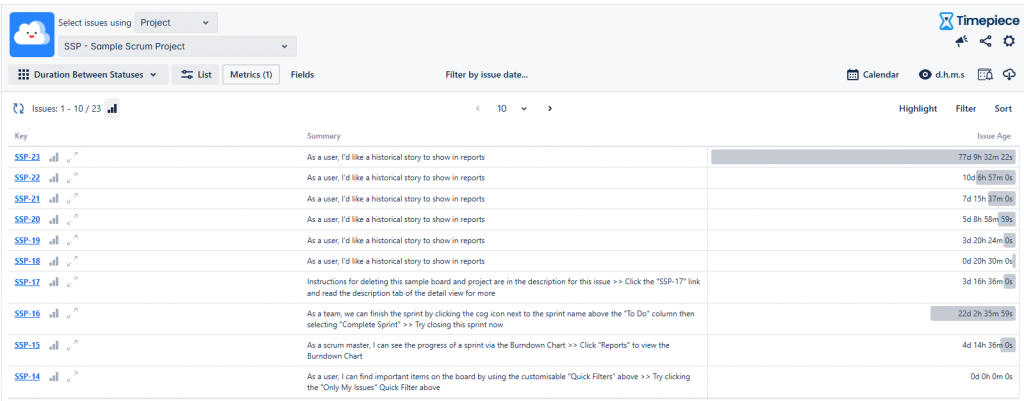
With the “Duration Between Statuses” report, you can measure the time between any two points in your workflow, from any start status to any end status, while excluding pause statuses.
Automate Your Reports with Scheduled Reports & Alarms Feature
Manual report generation is a time-consuming bottleneck. The Scheduled Reports & Alarms feature in Timepiece empowers you to automate your entire reporting process, making your workflow smarter and more efficient. You can configure your essential Timepiece reports to run automatically on a schedule you define and it can distribute them to key stakeholders. This automation saves valuable time and ensures consistent, standardized reporting across your organization.
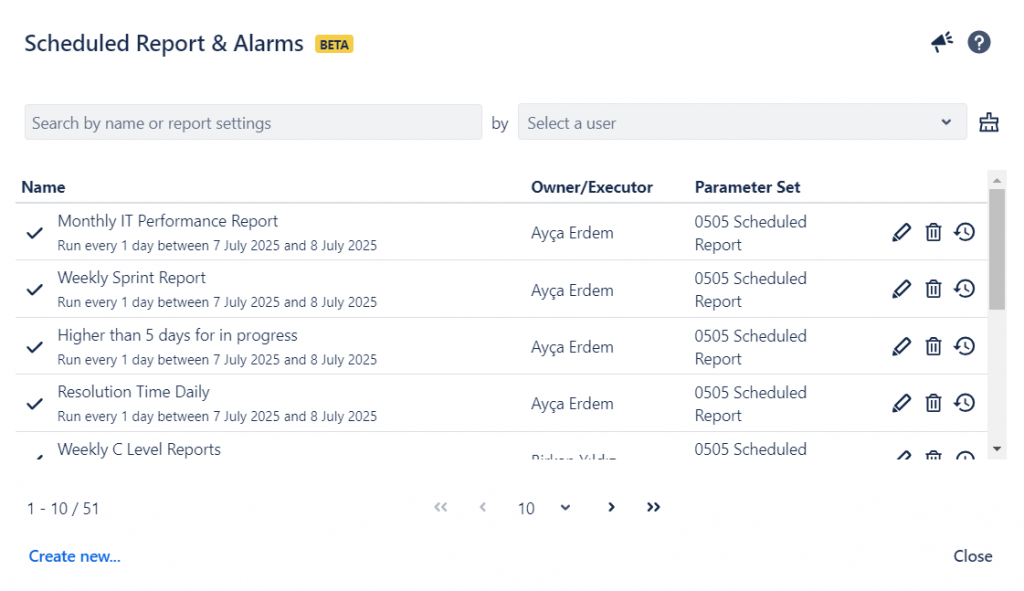
Beyond scheduling, the Alarms functionality turns Timepiece into a proactive early warning system. You can set up custom alerts for specific conditions, such as notifying a manager if an issue remains ‘Blocked’ for more than 4 weeks. By paying attention only when it’s truly needed, you can identify and address critical bottlenecks before they escalate, allowing your team to move from reactive problem-solving to proactive leadership.
Powerful Integrations and a Full REST API
Your Jira data is most powerful when it can be combined with information from other business systems. Timepiece – Time in Status for Jira offers a full-featured REST API that gives you programmatic access to all your report data. REST API allows you to build custom integrations with BI tools (Power BI & eazyBI, and others).
Cloud Fortified and ISO Compliant
Adopting a new application in an enterprise environment requires the highest levels of security and trust. Timepiece is recognized by Atlassian as a Cloud Fortified app, indicating that it meets the highest standards for security, reliability, and support. Furthermore, Timepiece’s developer OBSS is ISO 27001 certified.
Jira Time Tracking: Frequently Asked Questions
Effective time tracking is a cornerstone of successful project management, enabling teams to plan resources, monitor progress, and ensure profitability. Here are some of the most common questions about Jira time tracking, and answers.
What’s the difference between a time tracking ‘app’ and a ‘plugin’ in Jira?
In today’s Atlassian ecosystem, these terms are used interchangeably, but ‘app’ is the current and correct terminology. In the past, add-ons for self-hosted Jira Server instances were often called ‘plugins.’ Today, with the shift to Jira Cloud, all integrations found on the Atlassian Marketplace are officially referred to as ‘apps.’ So, if you’re searching for a solution, looking for a “Jira time tracking app” will give you the most relevant and up-to-date results.
Can installing a time tracking app slow down my Jira instance?
This is a valid concern for any Jira Administrator. A poorly built app can indeed impact performance. However, apps that have earned Atlassian’s Cloud Fortified status have undergone rigorous technical reviews by Atlassian to ensure they meet the highest standards for security, reliability, and performance. When choosing an app, always look for the Cloud Fortified badge to minimize any risk and ensure the solution is optimized to work efficiently with your Jira instance without causing slowdowns. Timepiece, won’t add steps to your regular workflow or constantly listen for your activities; it only runs when you request a report.
